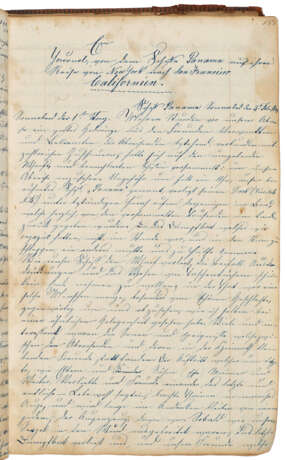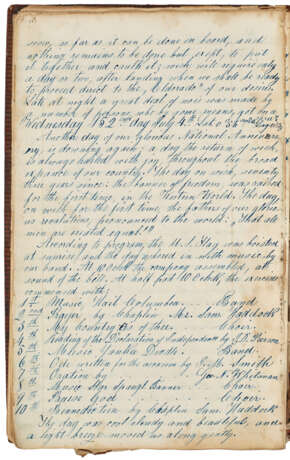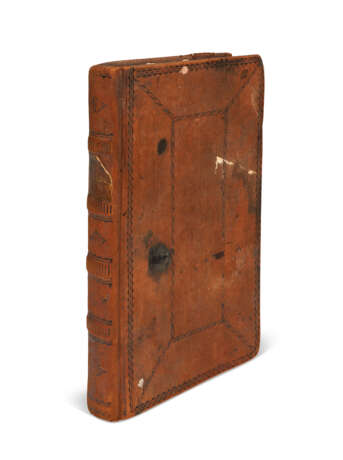ID 1129825
Лот 205 | The journal of a '49er
Оценочная стоимость
$ 8 000 – 12 000
In English and German. 314 pages, 313 x 192mm, written in ink over older ledger entries in several places, occasional penciled corrections (some marginal wear, light dampstains and occassional soiling). Bound manuscript day book (spine separated and early pages loose). Leather boards with black tooling, ribbed spine with label (rubbed at extremities, soiled spots, blade marks, small loss to label). 1934 transcripts: 79 pages, various sizes, but mostly 213 x 203mm., some pages joined at top margins (occassional marginal tears and losses, but overall very good).
The Gold Rush journal of Lewis Meyer, chronicling, in remarkable detail, his journey from New York to San Francisco aboard the ship Panama together with entries from his first weeks in San Francisco. Meyer was born in Germany to a landed family who emigrated to New York in 1838, where he established himself as a grocer. Already well-educated, Meyer took time to study English, which he had largely mastered by the time he learned of Sutter's discovery in late 1848. On the news of gold, Meyer joined with one of the many associations that formed to purchase ships bound for California, and on 3 February 1849, Meyer set sail on the ship Panama. Meyer kept his journal in a previously little-used day book dating from 1839 and his daily entries, each of which additionally notes the day of the voyage as well as the latitude and longitude, jump about the book as he ran out of blank pages and began to write over earlier day book entries. The entirety of his 187-day voyage and his first two weeks in California are written in English. Meyer additionally translated the first nine weeks of the voyage into German (3 February - 13 April 1849).
The journal is extremely well-written and very descriptive, far more than most argonaut journals kept on the perilous voyage "around the horn" that we have encountered. Meyer writes that the Panama's departure was witnessed by "a large crowd" of "friends, relations and acquaintances of the departing" on the pier, "with numerous spectators … assembled on the surrounding piers and on board the neighboring shipping," that numbered in the thousands by the time the ship left "pier 6, N[orth]. River." Meyer marveled in the deeply moving spectacle, "when parents and their sons, husbands and wives, lovers and friends bid each other the last final — farewell, started tears in many eyes — and will long be remembered by every one, who was an eyewitness to it."
Over the course of the voyage, Meyer takes pains to describe daily life aboard the Panama, chronicling (and reviewing) shipboard amusements including concerts (there were enough passengers aboard to form a small band), dramatic readings and other amusements as well as detailed commentary on the social dynamics of shipboard life. He describes the monotonous diet of beef and bread for breakfast and pork and beans for dinner, punctuated by an offering of mackerel and cod on Fridays. At one point the quality of the food had become bad enough to provoke an "indignation meeting," where "a great many loud complaints were made," about the quality of service by the "cooks stewards and waiters." The meeting resolved to place control of food in the hands of the ship's captain. Several days later, Meyer was happy to report that "Our 'domestic affairs' on board, are very encouraging at present. We now have an aboundence [sic] of food every day, prepared in the best possible manner. The saltishness of the beef and pork, is so reduced by soaking and other means, that it becomes very palatable; and the fresh bread w[h]ich we now have every other morning, is of a very good quality."
Although the ship had been purchased by the California Mutual Association, many of the 202 aboard were paying passengers, many of whom formed mining companies to pool resources and share risk. On 9 March, while crossing the Equator in the Atlantic, Meyer was elected President of the "Independent Mining Company," and adopted a constitution that he dutifully recorded in the ledger book and signed together with his brother, Marx Meyer, and six others, all German immigrants.
Over the course of the 187-day voyage, the Panama made a single port call at Talcahuano, Chile for provisions where Meyer and his fellow passengers spent over two weeks alongside numerous other California-bound vessels. Meyer describes the people and landscape in tremendous detail, noting that the houses were "small, only one story high, and those of the lower clas[s]es generally have but one apartment. The houses of the more wealthy class are mostly buildt [sic] of bricks, and subdivided…. The houses on the outskirts … on the slope of the hills and on the road to Concepcion: are the most wretched habitations, I ever laid eyes upon! They are nothing but small huts, covered with mud, so think put on sometime that the eye will penetrate almost any part…. These miserable hovels, appear to be the abodes, of that part of the population, in w[h]ich the Indian blood predominates." A few days later, Meyer and a small party journey to see the city of Concepcion where he found far more stately houses than in Talcahuano, but many of which remined in ruins following the devastating earthquake of 1835. While in Talcahuano he describes violent disturbances between the local population and the flood of foreign visitors who had stopped there on their way to California. On their final day in port, he describes a visit to several of the town's "Fandango Houses," or simple grog shops, frequented by prostitutes, or "senoritas", that offered musical entertainment. Meyer was not fond of the entertainment he found, recalling one choice performance once back aboard ship: "gracious heaven! what a yellowing disagreeable voice! Never on no previous occasion, have I heard such singing, the displeasing sounds… [which] seem still to be ringing in my ears."
While crossing the Equator (the second time) on 4 July 1849 in the Pacific, Meyer takes time to offer a vivid description of the ceremonies held aboard the Panama: "Another day of our glorious National Anniversary, is dawning again; a day the return of w[h]ich, is always hailed with joy… The day on w[h]ich, seventy three years since: the banner of freedom, was raised for the first time, in the Western World … the fathers of our glorious revalutions [sic], pronounced to he world: 'That all men are created equal!'" The day's program commenced at 10 am with the band playing "Hail Columbia," a prayer by the ship's chaplain, followed by the singing of "My Country 'tis of thee," by the ship's choir, a reading of the Declaration of Independence and an oration interspersed by more music including the "Star Spangled Banner." That evening, the ship's passengers staged a "dramatic exhibtion" which included scenes from various popular productions and various songs. Meyer takes time to review each performance and the audience's reaction (both positive and negative). The evening ended with two of "the most rowdy fellows we have on board," running about the deck, staging mock fist fights and wrestling matches, which "kept the spectators almost constantly in a roar of laughter," although their antics nearly provoked a real fight aboard ship.
Tensions mounted late in the voyage as the Panama sailed to the northwest awaiting the right moment to sail west toward the Golden Gate...
| Автор: | Льюис Мейер (1818 - 1900) |
|---|---|
| Место происхождения: | США |
| Категория аукционного дома: | Письма, документы и рукописи |
| Автор: | Льюис Мейер (1818 - 1900) |
|---|---|
| Место происхождения: | США |
| Категория аукционного дома: | Письма, документы и рукописи |
| Адрес торгов |
CHRISTIE'S 20 Rockefeller Plaza 10020 New York США | ||||||||||||||
|---|---|---|---|---|---|---|---|---|---|---|---|---|---|---|---|
| Предосмотр |
| ||||||||||||||
| Телефон | +1 212 636 2000 | ||||||||||||||
| Факс | +1 212 636 4930 | ||||||||||||||
| Условия использования | Условия использования | ||||||||||||||
| Транспортировка |
Почтовая служба Курьерская служба Самовывоз | ||||||||||||||
| Способы оплаты |
Банковский перевод | ||||||||||||||
| Часы работы | Часы работы
|







